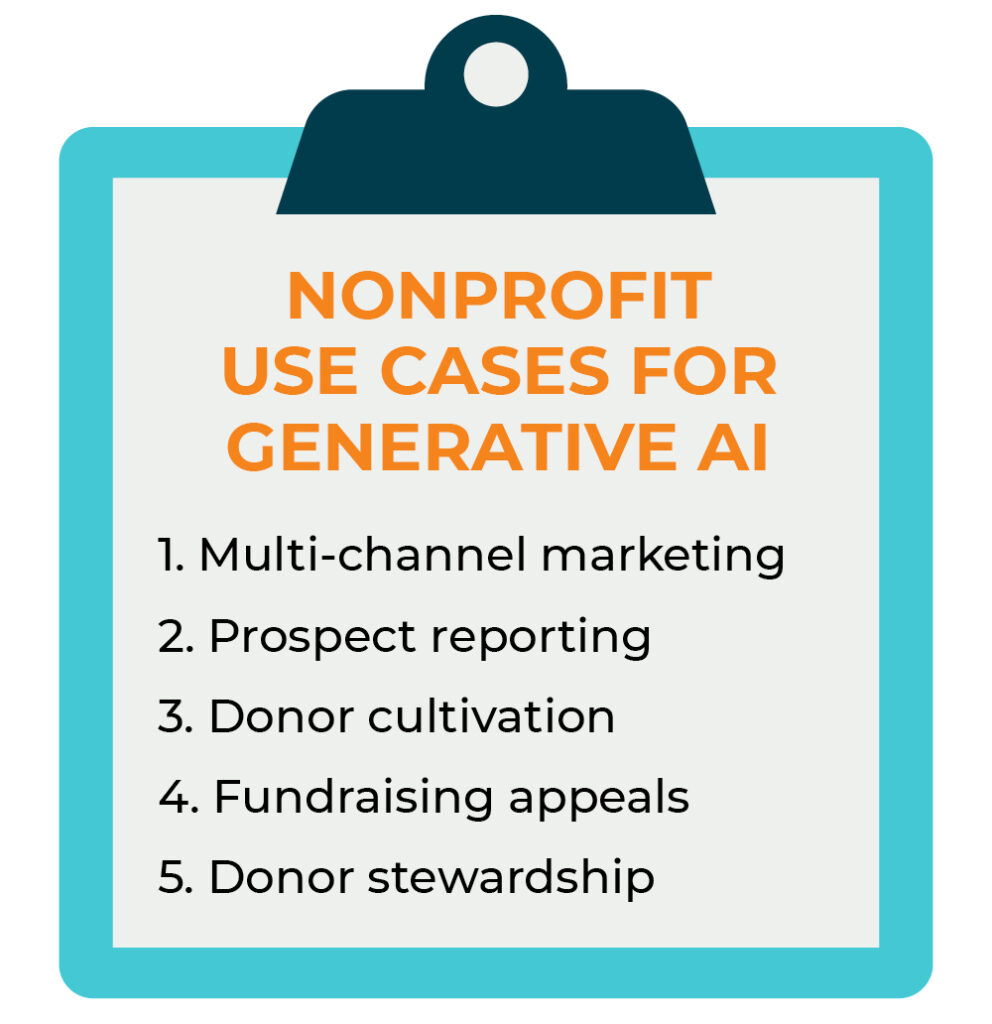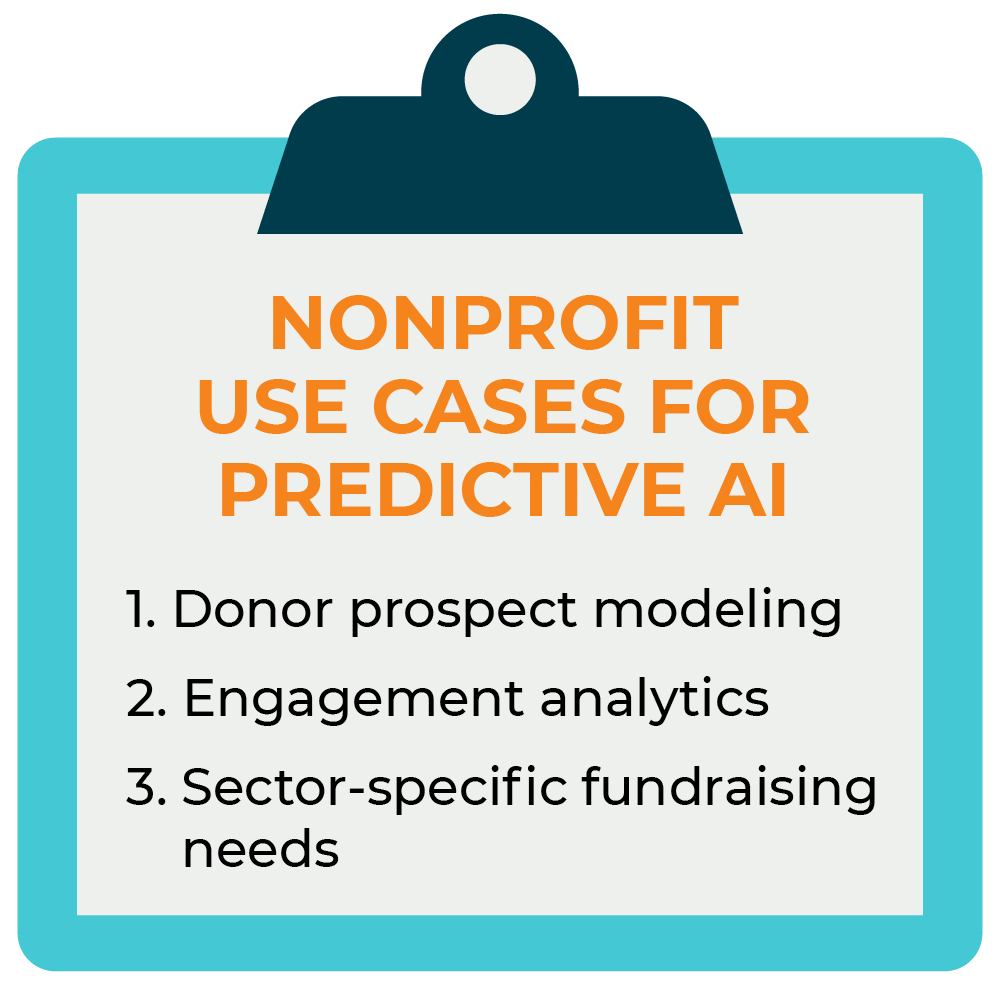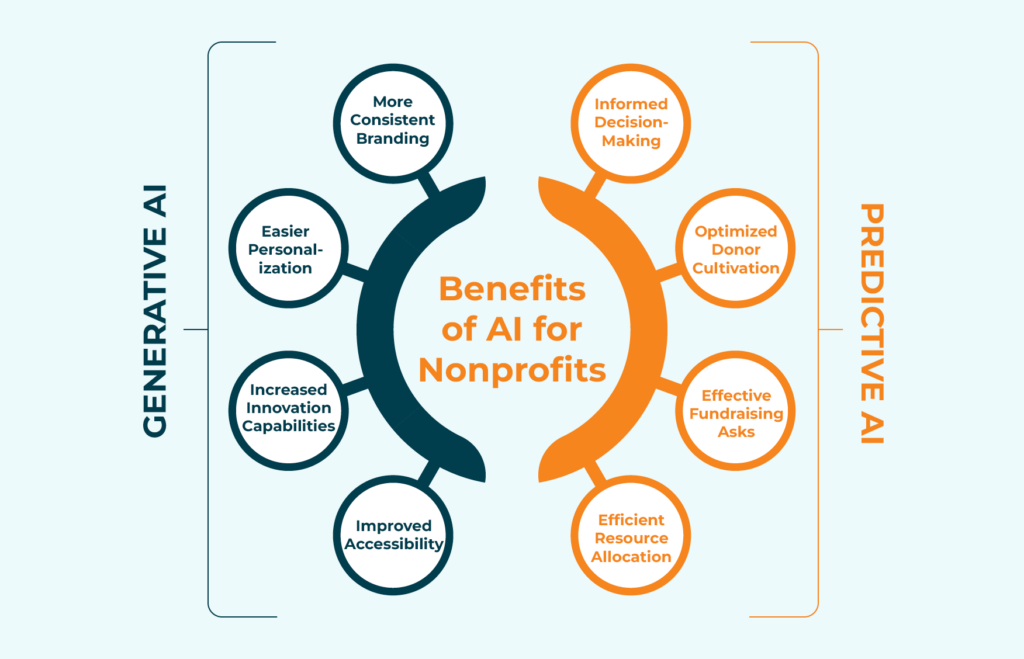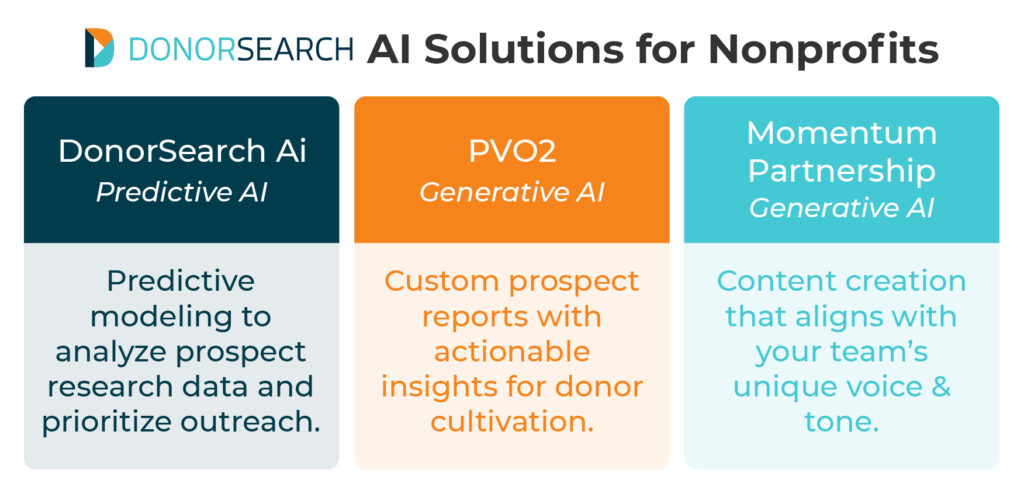
Generative AI vs. Predictive AI: A Complete Nonprofit Guide
As artificial intelligence (AI) has become a larger part of daily life, it has also greatly impacted the nonprofit sector. Many nonprofits are using AI-powered solutions to streamline their operations, boost their fundraising efforts, make data-driven strategic decisions, and more.
If your organization is considering incorporating these tools into its strategy, you should first be aware of the differences between the two main types of AI: generative and predictive. In this guide, we’ll cover the basics of both generative AI and predictive AI as they relate to nonprofit work, including:
- Generative AI vs. Predictive AI: An Overview
- Benefits of Generative and Predictive AI for Nonprofits
- A Closer Look at DonorSearch’s Generative AI and Predictive AI Solutions
While each category of solution plays a different role in your organization’s activities, AI fundraising strategies are most effective when they incorporate both generative and predictive tools. Let’s get started by reviewing the definitions and nonprofit-specific use cases of generative AI and predictive AI.

Generative AI vs. Predictive AI: An Overview
To understand generative and predictive AI, you first need to know what AI is generally. Artificial intelligence is the ability of a computer to “think” in a similar way to humans. These machines can process (or “learn”) a large amount of information, recognize patterns, and make data-driven recommendations.
Now that we’ve defined that key term, let’s dive into the specifics of generative AI and predictive AI.
Generative AI
Generative AI refers to a category of AI solutions that are designed to develop new, original content like written copy, images, and videos. These tools recognize patterns in the datasets they’re “trained” on and use those conclusions to produce outputs.
Research shows that the best-known generative AI solution is ChatGPT, which provides written responses to users’ questions or prompts. Some other popular tools in this category are Grammarly (real-time copy editor), DALL-E (image generator), and Synthesia (video creator). In the nonprofit sector, leading generative AI tools include DonorSearch Ai + Momentum and ProspectView Online 2 (more on these later!).
Nonprofits can leverage generative AI in a variety of ways—here are a few of the most common uses for it:

- Multi-channel marketing. Generative AI tools can draft website copy, produce videos for social media, generate email templates, and aid in other content creation tasks so your nonprofit can market its mission more effectively with fewer resources required.
- Prospect reporting. AI-generated prospect reports provide concise summaries of potential nonprofit donors so you can understand their giving likelihood at a glance and prioritize your outreach efforts accordingly.
- Donor cultivation. Using AI to aid in creating educational materials and personalized invitations can free up more time during the donor cultivation process to build relationships with prospects.
- Fundraising appeals. Once you’ve cultivated a prospect, you can use your AI tools again to draft donation requests for various campaigns and communication formats.
- Donor stewardship. Generative AI is also useful for thanking donors in a variety of ways, from writing donation acknowledgment letters to making appreciation videos to deciding what to say when presenting them with awards.
The bottom line of generative AI is that it helps your organization create more effective and streamlined materials for fundraising and donor engagement. However, gathering support for your mission still requires a human touch—despite their intelligence, today’s AI solutions can’t form emotional connections with prospects. Therefore, you should use generative AI outputs as a starting point and revise them to align with your audience’s needs and preferences.
Predictive AI
The term predictive AI generally describes AI solutions that analyze and model data. These tools use their machine learning and pattern recognition capabilities to predict future trends and make recommendations based on those projections.
DonorSearch Ai is the most advanced predictive AI solution in the nonprofit sector, helping nonprofits make sense of their prospect research data and tailor their strategies accordingly (more on this later, too!). Other popular predictive AI tools include Tableau and Google Cloud Smart Analytics.
Some ways your nonprofit can leverage predictive AI include:

- Donor prospect modeling. While standard prospect research only provides a general sense of a potential donor’s giving capacity and affinity, AI-powered predictive modeling ranks how likely a prospect is to give to your organization. This way, you can prioritize reaching out to those with the highest giving likelihood ratings.
- Engagement analytics. Predictive AI can help you see how donors have responded to various outreach and fundraising appeals in the past so you can build on the strategies that work and improve upon or eliminate less effective ideas.
- Sector-specific fundraising needs. AI-supported analytics can especially help organizations in niche sectors like healthcare and higher education model their unique data and inform their strategies.
Predictive AI also requires human oversight for maximum effectiveness—rather than letting machines create entire strategies for you, factor their outputs into your larger decision-making process for the best results.

Benefits of Generative and Predictive AI for Nonprofits
In addition to their respective use cases, generative AI and predictive AI also provide distinct advantages for your nonprofit. Let’s look at the benefits of each in more detail.

Generative AI Benefits
By streamlining content creation with generative AI, your nonprofit can experience:
- More consistent branding. Branding encompasses not only the visuals that represent your nonprofit, but also the tone, word choice, and writing style present in your messages. Generative AI can help you hone all of these elements to ensure your branding is unified across communication channels.
- Easier personalization. Personalized communications show donors that your organization values them as individuals, not just revenue sources. When you can automate the repetitive aspects of donor communications with AI, it frees up more time to focus on tailoring messages to individual supporters.
- Increased innovation capabilities. Generative AI makes it easier to explore new marketing and fundraising methods, helping you stay on top of trends and keep your donors engaged with fresh content and opportunities.
- Improved accessibility. As they generate content, your nonprofit’s AI solutions can suggest alternative text for digital images, create closed captions for videos, and take other steps to ensure all of your nonprofit’s supporters can engage with your content—including those with disabilities.
Predictive AI Benefits
Improving data analysis with predictive AI provides your nonprofit with the following advantages:
- Informed decision-making. As mentioned previously, you shouldn’t rely on AI to make decisions for you, but predictive AI insights should assist in your decision-making processes for strategic planning, donor outreach, and other key nonprofit activities.
- Optimized donor cultivation. Predictive AI can provide data-backed suggestions for how best to engage each of your donors, guiding your relationship-building efforts.
- Effective fundraising asks. With AI-powered analysis of prospects’ giving capacities, you won’t have to worry about asking too much of them or leaving money on the table when soliciting major gifts, annual fund contributions, or any other donations.
- Efficient resource allocation. By segmenting prospects and prioritizing outreach based on predictive AI suggestions, you can make sure your team’s time and resources are going toward acquiring the right donors to meet your nonprofit’s needs.
Risks Associated with AI
While we’re discussing the benefits of generative and predictive AI, it’s important to note that both types of tools also have associated risks. AI is still evolving, and issues with data security, legal compliance, and biased information outputs can occur if these solutions are used improperly.
However, the advantages of AI tools for nonprofits far outweigh these risks, as long as your organization commits to using AI responsibly . Prioritize transparency, accountability, inclusivity, and data ethics when leveraging any generative or predictive AI solution to maximize its benefits and minimize its potential drawbacks.
A Closer Look at DonorSearch’s Generative AI and Predictive AI Solutions
As the leader in nonprofit prospect research, the DonorSearch team has built on our commitment to help organizations identify and connect with high-impact donors by rolling out two new generative AI offerings: ProspectView Online 2 (PVO2) and a partnership with Momentum. These work alongside our existing predictive AI tool, DonorSearch Ai , to provide actionable insights for connecting with prospects and optimizing outreach.
Let’s look at each of these solutions in more detail:

Predictive AI: DonorSearch Ai
DonorSearch Ai is the most advanced machine learning solution designed for the nonprofit sector. It analyzes donor and prospect data to assign scores based on donors’ likelihood to respond to fundraising appeals.
Some of the in-depth insights your nonprofit can glean about prospects using DonorSearch Ai include:
- Probability of acquiring new donors
- Approach methods new donors are most likely to respond to
- Best target ask amounts for new donors
- Optimal time frames for making fundraising asks
- Likelihood of retaining existing donors over the next 12 months
- Probability of donors becoming sustainers (i.e., giving multiple times in the next year)
- Likelihood that donors will accept visits from your team
Your organization can use these scores and models to prioritize reaching out to individuals who have the best chance of becoming loyal supporters of your mission.
Generative AI: PVO2 and Momentum
PVO2 is the most up-to-date version of our prospect generator tool, which now includes AI-driven reporting. Your nonprofit can generate custom prospect reports for each potential donor on your list, allowing you to view a concise summary of each individual’s wealth and philanthropic indicators for more streamlined cultivation.
Momentum is a nonprofit-specific generative AI platform that is now partnered with DonorSearch. Based on DonorSearch Ai’s predictive modeling, Momentum can generate email and letter templates, call scripts, and other outreach materials. To further streamline content creation, these outputs align with the writing voice and tone of your organization’s major gift officers, as well as the prospect’s history and interests.
By combining these three tools, your nonprofit can make the most of prospect research insights and boost its fundraising results. But don’t just take our word for it—check out this video to learn how Champlain College used DonorSearch Ai to future-proof its major donor fundraising strategy:
Final Thoughts
Generative AI and predictive AI play different but complementary roles in your nonprofit’s fundraising success. Before investing in any AI fundraising tool, make sure to research the solution thoroughly to ensure its capabilities will meet your organization’s needs and that its provider is committed to responsible AI use and innovation (as DonorSearch is!).
For more information about AI and its applications for fundraising, check out these resources:
- AI for Nonprofits: Everything Your Org Needs to Know. Discover even more strategies, benefits, and answers to common questions regarding AI and its use in the nonprofit sector.
- Moves Management: How to Cultivate Donor Relationships. Explore the ins and outs of moves management fundraising, including how AI can apply to various aspects of the donor journey.
- Major Donor Fundraising: How to Strengthen Your Strategy. Learn more about how to leverage AI and other tools to solicit high-impact gifts for your organization.

